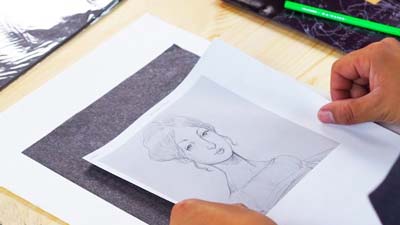
Do you want to learn how to transfer an image to another using graphite paper? If so, you are in the right place.
Learning how to properly apply graphite paper is quite easy and does not take much time once you get the hang of it.
As an artist learning the perfect way to use graphite paper is quite useful. Using regular sheets just don’t do the trick. They are generally too thick, and it’s quite hard to trace it that way.
Luckily for us, graphite paper makes it a lot easier to trace a drawing rather than having to hold the sheet to the sunlight.
Lets start
Methods to Use Graphite Paper
Tracing a drawing is quite hard without the right tools. Perhaps, you have used regular sheets to try and trace a drawing. However, most of the time, those sheets are too thick to see through them.
Even holding them to the sunlight to try and trace it can be quite hard and inconvenient for the most part. This is why it is always a great idea to use graphite paper for tracing.
To successfully trace a drawing using graphite paper, you must follow these steps:
Gather the Resources
You don’t need many things to use your graphite paper. However, we have found a few things that are quite useful. So, it is worth giving them a try to speed up your workflow.
- Tape
- A ghost pen to trace the drawing
Read More: What is Paper Crafting Called? Here are the most fun paper crafts and how to start!
Choose the Image
Before getting started, you must choose a drawing or an image that you want to transfer onto your new sheet.
We highly recommend using a copy of the original image. You will be drawing on top of your image, so you don’t want to draw over the original one. Instead, use a copy of the drawing.
It is also helpful to use a black and white copy of the original image. You can use third-party programs such as Photoshop to achieve such results.
The idea behind this is to be able to make out the image when you begin tracing it.
Using Coloring Paper
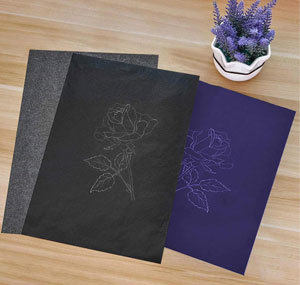
After you have chosen your drawing, you need to get a clean coloring paper. This is the best type of paper you can use for Graphite paper.
The texture of the coloring paper is kind of rough to the touch. That is perfect for the Graphite paper as you can easily use it to trace your desired image.
So, you simply have to place it between the copy of your image and the Graphite paper. This way, you won’t muck up your coloring paper with heavy pencil lines.
You must be careful when doing so as you could end up with constant rubbing out on your coloring paper. So, it’s just best to sketch on a different paper and then transfer it onto a new sheet.
Placing the Graphite paper
The first thing you must do is to place the graphite paper on the dark side. The dark side must be facing down the coloring paper. And the clean side must be up.
After that, you must place a copy of your desired image on top of the clean side.
Tape
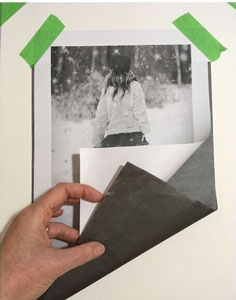
You are free to skip this step, but we strongly recommend doing this for better results. Using tape is a great way to make sure your image does not move when you are tracing it.
What you have to do here is to use tape on the coloring paper and tape it to whatever surface the paper is on.
This is just to ensure that everything goes smoothly. Otherwise, your lines would not line up. This could be inconvenient if you don’t have much time and need to get it done as soon as possible.
Tracing the Image
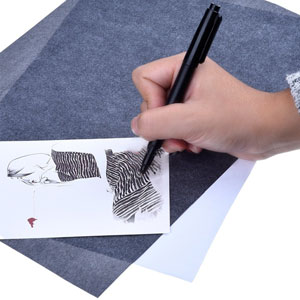
Now that you taped everything down, you can finally start to transfer. Feel free to use any type of pen you want for your drawing.
However, if you don’t want to damage the copy of your image, you could use a ghost pen. The only issue you are going to face is that you can’t see where you have traced.
However, if you feel confident enough about your skills, feel free to go ahead.
Once you have chosen your pen, you may begin to trace the image. As you use your pen, make sure to apply some pressure to your drawing paper.
From there, you just have to go over all the lines that you want to trace. The cool thing about it is that if there is a specific part of the drawing that you don’t like or would like to change, you simply don’t have to transfer that part.
Pull Up the Paper
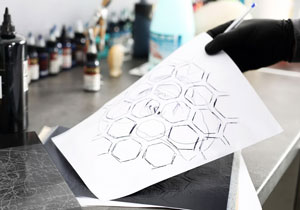
Once you have traced all the lines you wanted, you can lift up the paper to see the final results. You can see that the graphite has picked it up correctly.
Depending on how complex your drawing is, this could take some time. But overall, this process is quite simple and straightforward.
People Also Asked
Still have some questions about graphite paper? You may find the answer below:
Which side of the graphite paper goes down?
The dark side of the graphite paper must always go down. And the other side must be facing up. When you have done that, you simply need to place it on top of the drawing you are trying to trace.
Is graphite paper reusable?
Yes, it is reusable. You can use graphite paper quite a few times. You don’t have to throw it away until the graphite is wholly gone. So, if you are looking to save a few bucks, this is a great way to do so.
Does graphite paper work on canvas?
Yes, graphite paper does work on canvas. It works just fine like it would with any other type of paper.
What can I use instead of graphite paper?
If you don’t have graphite paper on hand, or you simply don’t want to use it, you can use any regular paper to transfer your drawing.
How do you remove graphite from paper?
Surprisingly, the easiest way to remove graphite from the paper is by using a soft eraser. You simply need to rub the eraser back and forth on the desired area. But you want to be careful not to apply much pressure on the paper.
Other Paper Crafting Resources:
- Measure the thickness of paper easily
- Top 15 essentials paper crafting items
- Using guidelines for sticker paper?
- Tips to transfer any design on your t-shirt
Concluson
As you can see, learning how to use graphite paper is quite simple and only requires a coloring paper and a copy of your drawing.
You don’t need a particular type of pen either. As long as you can use the pen to trace the drawing, it should work just fine.
However, we highly recommend using a ghost pen if you don’t want to damage the original drawing. From there, you just have to trace along the lines of your original drawing.
But overall, the process is pretty much straightforward, and after doing it for a while, you should be able to get the hang of it.